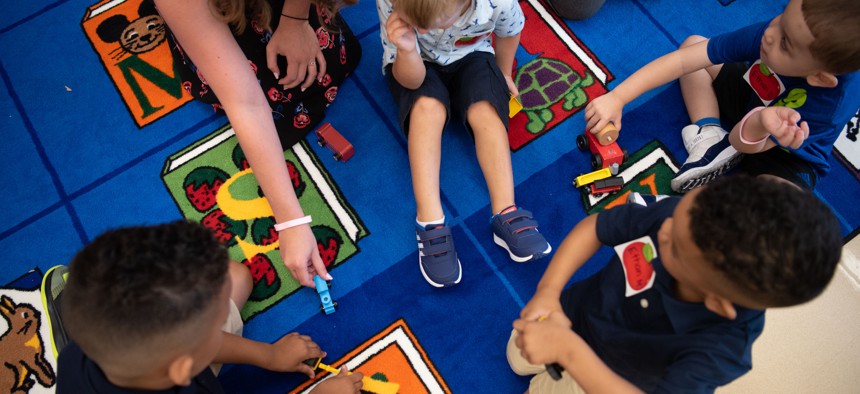Education
Report: NYC’s 3-K allowed for more moms to enter labor force
The findings came from a new poverty tracker launched by the Robin Hood Foundation and Columbia University.

New York City public school children at PS 377 in Ozone Park, Queens (Michael Appleton/Mayoral Photography Office)
Robin Hood and Columbia University have released a new poverty tracker report that examines how the availability of New York City’s 3-K for All program has increased the participation of mothers in the labor force.
Robin Hood - New York’s largest poverty fighting organization - and Columbia University’s Center on Poverty and Social Policy have been working together since 2012 and launched the poverty tracker after determining that the current measures of poverty weren’t accurately capturing the experiences of New Yorkers, especially as it relates to income poverty. Both looked at the specificity of hardships that New York City families faced such as running out of money for food or not having the funds to keep utilities running. The two organizations launched the tracker seeking something that was dynamic and detailed. The tracker allows for a rich data set but also allows them to see how things change over time for households.
The Early Childhood Poverty Tracker was released as a subset of an earlier, original tracker with a specific focus on families with young children. The Early Childhood Poverty Tracker is a longitudinal study of New York City families. It follows a representative sample of families with young children in New York City, providing a detailed description of the challenges and resources that shape the development of children during their critical early years. “We know that those experiences are so important as it comes to long term trajectories for children, so following the same families over time we are able to have this deep understanding of what families with young children in New York City are experiencing.” said Sarah Oltmans, Robin Hood’s chief of grant strategy.
The tracker uses repeated surveys with the same parents in order to understand how families’ circumstances change as their children grow. It has provided evidence that the availability of 3-K for All has allowed for the greater participation of mothers in the labor force.
The 3-K for All program was first introduced to a few districts in 2017 with priorities for the highest need districts in terms of pre-K services, however it was made available to all districts by 2021. The 3-K for All initiative is a program for three year olds which provides children with free, full day, high quality early education. Mothers who lived in districts that had 3-K availability showed higher rates not just of labor force participation, but full time employment.
Also, this trend continued for working mothers even after their initial 3-K year which highlighted evidence of continuity in their work force presence. “In the data that we already have, we see the heightened employment and full time employment continuing even after the 3-K year. So it suggests that once women are able to get into the labor market and move into full time employment, that continues, so there are lasting benefits.” said Dr. Jane Waldfogel, co-director of the Columbia Population Research Center and a Compton Foundation centennial professor of social work for the prevention of children’s and youth problems. These lasting effects are seen as important in terms of a family’s economic well being and also in terms of family routines and stability.
The children who were followed by the early poverty tracker were all under the age of three when the study began and so they were able to look especially at their experiences of early childhood care and education, whether that is within the city’s universal preschool program or experiences of other types of child care. This became an important focus of the tracker, however it was also looking at their experiences at home, their parent’s employment, and various measures related to income, health and wellbeing. There have been a variety of well documented studies and research done on the benefits of pre-K and 3-K on childhood development, especially on children’s cognitive development and school readiness. However, as Waldfogel told New York Nonprofit Media, “There’s been much less attention in the previous research for the benefits in terms of parental employment. And yet we know that childcare is a really important factor in enabling parents to work and to be able to work more hours once they are working.”
3-K programs are crucial in supporting mothers’ initiatives to “seek a job and work more hours and this can be extremely beneficial for children’s development as it can provide better economic stability and resources for families” said Eunho Cha, a doctoral research assistant at the Center on Poverty and Social Policy at Columbia University. This is especially true since there are many mothers who are dissuaded from reentering the labor force because of the high costs of childcare. By the time a child is three years old, they are developmentally ready to get formal education but if the cost is too high, mothers that want to go back to work might be burdened by the responsibility of childcare.
There are still some communities that have not been able to take full advantage of the 3-K program. This can be because it’s not as widespread in their neighborhood, or because it’s not offered during the hours that they need childcare. “That’s one of the reasons why it’s so important to have a system that can really support working families, working mothers, depending on whatever hours they are working. So I think pre-K is a great step and it makes it more affordable for families” said Oltmans. Previous studies showed that about 87% of working mothers were using childcare if they had young children. Oltman told NYN Media that “we know that these resources are just so critical for labor force engagement, but so often they are unaffordable for families.”
